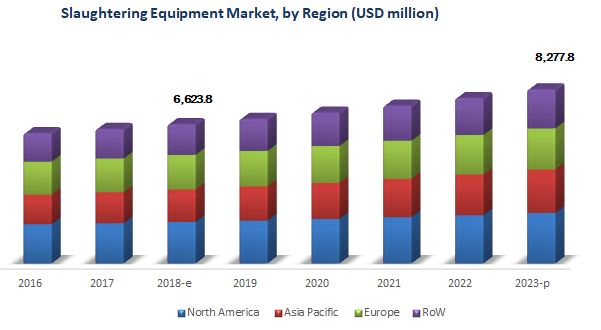The global slaughtering equipment market is estimated at USD 6.62 Billion in 2018 and is projected to reach USD 8.28 Billion by 2023, at a CAGR of 4.56% during the forecast period. The market is driven by factors such as the growth of fast food and restaurant chains; increase in demand for processed food; lenient trade policies & increase in meat exports; and technological advancements in the slaughtering equipment industry. The mechanization and automation of processes have become a necessity in order to maintain standard cut-up size and identical fillet size, which are a pre-requisite in the fast food and restaurant businesses. Moreover, slaughtering equipment manufacturers and meat processing companies are collaborating for enhanced technological advancements, thereby driving the growth of the slaughtering equipment market.

Download PDF Brochure:
https://www.marketsandmarkets.com/pdfdownloadNew.asp?id=176187219
Based on livestock, the slaughtering equipment market has been segmented into poultry, swine, bovine, seafood, and others, which include ovine and caprine. The poultry segment dominated the global market for slaughtering equipment in 2017, and this trend is expected to continue through the forecast period. The demand for poultry has been growing significantly worldwide, which led to an increase in demand for poultry slaughtering equipment such as killing, cut-up, deboning & skinning, and evisceration equipment. Most large-scale poultry meat producers use automated poultry slaughtering line for high capacity production.
On the basis of automation, the slaughtering equipment market has been segmented into fully automated line and semi-automated line. The semi-automated line method segment dominated the global market for slaughtering equipment in 2017. Semi-automatic slaughtering lines consist of some automatic machines as well as manual labor-oriented processes during slaughtering. Semi-automated lines have lower initial investments and require low maintenance costs, which are its main advantages over automated slaughtering equipment.
The Asia Pacific region witnesses a high consumption of meat in urban areas; the increase in demand for processed meat products drives the growth of the market for slaughtering equipment in the region. The market for slaughtering equipment in the Asia Pacific region is projected to be the fastest-growing globally, as economic growth and rapid urbanization increased the demand for slaughtering equipment among meat producers to meet the increasing demand of meat products in the region.
Speak to Analyst:
https://www.marketsandmarkets.com/speaktoanalystNew.asp?id=176187219
The key players in the global slaughtering equipment market include Marel (Iceland), BADDER Group (Denmark), BAYLE SA (France), Prime Equipment Group (US), CTB (US), Brower Equipment (US), Jarvis Equipment (India), Industries Riopel (Canada), ASENA (Azerbaijan), Dhopeshwar Engineering Private Limited (India), Meatek Food Machineries (India), BANSS (Germany), Limos (Slovenia), Best & Donovan (US), and Blasau (Spain).
Targeted Audience:
- Raw material suppliers
- Traders and distributors of feed processing equipment
- Feed processing equipment manufacturers
- Regulatory bodies
- Intermediary suppliers
- Feed manufacturers
- Trade associations and industry bodies
- Government and research organizations